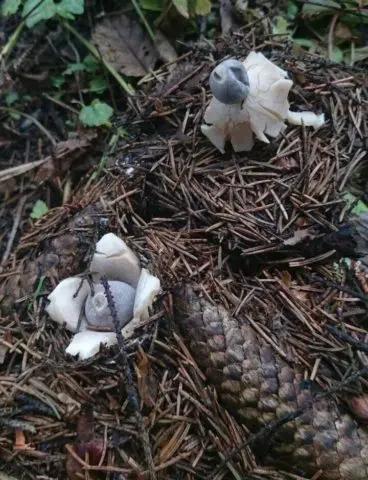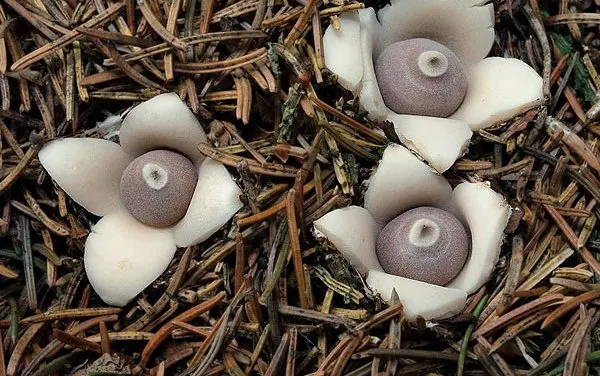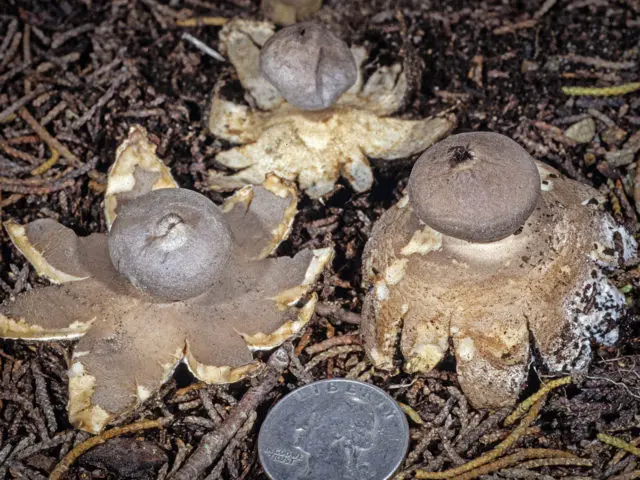Contents
Four-blade or four-blade star, Geastrum four-blade, four-blade earth star, Geastrum quadrifidum are the names of one species of the Geastraceae family. It has no nutritional value, it belongs to inedible mushrooms. It is listed in the Red Book of the Tver and Voronezh regions as a rare species.

Geastrum four-lobed – a mushroom with an unusual structure of the fruiting body
What does a four-bladed star star look like?
At the beginning of development, the reproductive part is underground, the peridium is closed, rounded – up to 2 cm in diameter, the white surface is covered with micellar hyphae. In adulthood, the size of the fruiting body increases to 5 cm, the peridium, when leaving the soil, is divided from four to seven pointed lobes. The four-layer structure consists of the outer part – the exoperidium and the inner part – the endoperidium.
External characteristics of the four-bladed star:
- The exoperidium consists of two or three layers, torn to the middle from the upper part into uneven lobes.
- At the beginning of the opening, it looks like a bowl with non-hygroscopic upright edges. Then the surface is divided into parts, the blades are bent to the ground and lift the fruiting body above the surface.
- The outer coating is light, felt structure with fragments of soil and remains of mycelium, peels off and falls off over time.
- The pulp of the central layer of the exoperidium is dense, white and hard.
- The topmost layer falls off over time, leaving torn patches.
- The surface is filmy or leathery, darkens over time to brown and cracks.
- The endoperidium of the fruiting body is a gleba, spherical or ovoid, up to 1 cm wide, 1,4 cm high, covered with a protective and hard velvety film with a hole for ejecting spores.
- At the initial stage of development of a rounded formation, the color is light gray, in mature mushrooms it is black or dark brown.
- The gleba is attached to a short felt-coated post; a protrusion is clearly defined at the junction.
The spore powder is dark gray with an olive tint, and shatters when pressed.

The color of the top of the inner part is white with a clear border around the circle.
Where and how to grow
The four-lobed starfish is a rare species that grows on sandy, well-drained soils, among fallen needles on leaf litter, near abandoned anthills. It occurs in all types of forests, which include coniferous and broad-leaved species.
Fruiting is autumn, the first mushrooms appear in August, the last ones are found in October. They grow in small groups, often singly. The distribution area in Our Country covers:
- European and central part;
- Altai;
- North Caucasus;
- Eastern Siberia;
- Leningrad region.
Is the mushroom edible or not?
A small four-bladed star with a rigid structure of the fruiting body is not suitable for culinary use. It has no nutritional value. In biological reference books, the species is listed in the category of inedible mushrooms.
Twins and their differences
The vaulted asterisk is attributed to the twins of the four-lobed geastrum. Outwardly, the mushrooms are very similar – the way, place and time of growth do not differ. The double is determined by longer lobes – up to 9 cm, at the beginning of growth, the peridium is yellow-brown in color and opens into two layers. The pulp of an immature mushroom is white and dense.

The vaulted starfish has an antiseptic property, it is used in folk medicine
The crowned star, in contrast to the four-blade, breaks up to 10 blades when opened. Peridium does not exfoliate, in young specimens the color is gray with a glossy surface, with age the color becomes dark brown. The species can be found in parks among low grass under bushes. They are not used in cooking, the mushroom is inedible.

The inside of the asterisk crowned with a single color is painted in dark gray or brown.
Conclusion
Four-bladed starfish – a rare specimen with an exotic appearance, belongs to the inedible category. In many countries, including Our Country, it is listed in the Red Book. The cosmopolitan mushroom bears fruit at the end of summer on the coniferous litter of mixed forests.









